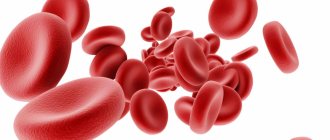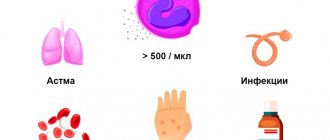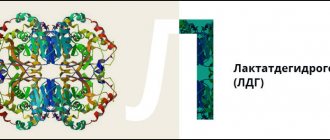Red blood cells produced in the bone marrow are called erythrocytes. Their transport function allows you to deliver oxygen to tissues at the cellular level and take carbon dioxide to the lungs. In addition to the main functionality, they take part in water-salt metabolism and regulation of blood acidity levels. For the normal functioning of the body, their quantity must correspond to age standards.
Normal indicators
The level of red blood cells contained in the bloodstream depends on the gender and age group of the patient. For a healthy person, the following level is acceptable:
- women – 3.7-4.7*1012 per liter;
- men – 4-5.1*1012 per 1 liter.
In childhood, the concentration of corpuscles constantly changes; for each month or day of a newborn’s life, there is a certain standard. Small fluctuations are observed after the first year of life, but the values are not particularly different from the same data for adults. At 12-13 years of age, the indicator is equal to adult values.
Classification Features
There are two types of erythrocytosis:
- Primary hereditary – refers to genetic pathologies, is rare. The source of the development of the disease is the low susceptibility of oxygen receptors in the kidneys and increased levels of erythropoietin. A sign of the disease is a pronounced loss of strength, attacks of dizziness, a change in the standard shade of the skin and mucous membranes into purple shades, and reduced blood clotting.
- Secondary or acquired - provoked by oxygen starvation of cells, occurs against the background of neoplasms in the liver, kidneys, and respiratory organs.
If the primary form of pathology is ignored, there is a risk of vascular complications, including thrombus formation. The problem is related to changes in the rate of blood clotting.
Causes of elevated red blood cells in the blood
An increased content of red blood cells in the blood is called erythrocytosis.
Depending on the reasons that caused the pathology, three types of erythrocytosis are distinguished: primary, secondary and false (or relative). Primary erythrocytosis occurs due to the development of primary polycythemia, a bone marrow tumor in which too many red blood cells, hemoglobin and white blood cells are produced. If the red blood cells are significantly increased - more than 6 Tera / liter - this is a symptom of primary erythrocytosis.
A secondary increase in the level of red blood cells in the blood can be caused by a lack of oxygen in the body tissues as a result of the following pathological processes:
- lung diseases (tuberculosis, pulmonary failure, etc.);
- heart failure;
- hemoglobinopathy is a hereditary genetic disorder of hemoglobin structure;
- intracardiac shunting of blood is a pathological process when venous blood enters the arterial bed, bypassing the lungs;
- hypoventilation syndrome - incomplete ventilation of the lungs due to blockage of the airways;
- oxygen starvation when smoking;
- staying in thin air in mountainous areas.
Also, the reasons for the increase in red blood cells in the blood may be hormonal disorders. If there is an excess of the hormone erythropoietin, then the red blood cells in the blood are significantly increased. A significant amount of erythropoietin in the blood is observed in the following diseases:
- polycystic kidney disease;
- malignant liver tumor;
- polycystic liver disease;
- tumors of the kidneys and adrenal glands of various etiologies;
- uterine fibroids, ovarian tumors in women;
- cerebellar hemangioblastoma;
- all types of anemia (deficiency of iron, vitamins B12, B9 (folic acid)).
A relative or false increase in the number of red blood cells can be observed with:
- extensive burns;
- dehydration (diarrhea, vomiting);
- use of diuretics;
- severe stress.
Primary sources of increasing values
Changes of physiological nature are provoked by:
- severe emotional stress;
- severe dehydration;
- long-term sports activities;
- living in high mountain areas.
The pathological form of erythrocytosis is associated with:
- with erythremia - tumor damage to the hematopoietic organs;
- heart defects - when arterial and venous blood is mixed, there is an insufficient supply of oxygen to the tissues; to compensate for the deviation, the bone marrow begins to produce a larger number of red blood cells;
- neoplasms in the kidneys, pituitary gland, adrenal glands or liver - the organs are responsible for the disposal of old elements in the blood, the formation of the disease leads to the cessation of this function, the tests indicate a predominance of mature forms;
- diseases of the respiratory tract and heart, infectious pathologies - a large number of young or reticular types of elements are observed;
- primary pulmonary hypertension;
- Pickwick's syndrome caused by obesity, pulmonary insufficiency, high blood pressure.
Less dangerous sources of development of an increased number of red blood cells include:
- lack of digestive enzymes;
- dehydration due to heat or prolonged physical activity;
- low-quality water: with chlorine, contaminated, highly carbonated;
- vitamin deficiency or deficiency due to liver dysfunction;
- smoking.
Against the backdrop of a large number of reasons causing changes in tests, only a doctor can correctly determine the original source of the deviation.
Increased hemoglobin
Diarrhea
Vomit
Thyrotoxicosis
17971 04 February
IMPORTANT!
The information in this section cannot be used for self-diagnosis and self-treatment.
In case of pain or other exacerbation of the disease, diagnostic tests should be prescribed only by the attending physician. To make a diagnosis and properly prescribe treatment, you should contact your doctor. Increased hemoglobin, or erythrocytosis: causes of occurrence, in which diseases it occurs, diagnosis and treatment methods.
Definition
Erythrocytosis is an increase in the content of red cells per unit volume of blood, accompanied by an increase in hemoglobin levels. The main symptoms of these changes are headaches, muscle pain, dizziness, nosebleeds, fatigue; more specific symptoms depend on the relevant disease.
Types of erythrocytosis
Erythrocytosis can be primary or secondary.
Primary erythrocytosis
is considered as an independent disease of the hematopoietic system and is of a genetic nature. Medically it is known as congenital polycythemia, or Vaquez's disease. This pathology provokes an increase in bone marrow volume and increased production of red blood cells and hemoglobin.
Secondary erythrocytosis is not considered a separate disease, but only a symptom of acute or chronic diseases and conditions. Relative erythrocytosis is a consequence of dehydration caused by excessive diarrhea or vomiting.
Also, an increase in hemoglobin levels can be the result of an overdose of medications, smoking, alcohol abuse and exposure to chemicals (nitrites).
Absolute erythrocytosis is a consequence of increased erythropoiesis, the process of formation of red blood cells in the bone marrow. This form of pathology is always associated with diseases of internal organs or systems.
Possible causes of increased hemoglobin
I. Hereditary:
- Changes in the structure of the Jak2 V617F gene, responsible for the production of red blood cells.
- Inability of blood to bind and transport oxygen to tissues.
- Reduced oxygen supply to the kidney tissues (this leads to the fact that they begin to intensively produce the hormone responsible for the formation of red blood cells (erythropoietin)).
- Deficiency of enzymes responsible for the production of red blood cells and their function of transporting oxygen to tissues.
II. Purchased:
- Kidney diseases (hydronephrosis, polycystic kidney disease, cancer and renal artery stenosis).
- Lung diseases (chronic obstructive bronchitis, bronchial asthma, diseases affecting lung tissue, sometimes of unknown cause).
- Heart diseases (congenital and acquired heart defects).
- Liver diseases (liver tumors).
- Brain diseases (in particular, cerebellar tumors).
- Diseases of the female reproductive system (ovarian cancer).
- Diseases of the endocrine system that affect the adrenal glands and contribute to increased blood pressure, in which the main drugs used for hypertension (Cushing's disease, pheochromocytoma) are usually ineffective, as well as diseases of the thyroid gland.
- Carbon monoxide poisoning.
- Staying at high altitudes.
- Obstructive apnea syndrome, characterized by temporary cessation of breathing during sleep.
Which doctors should you contact if your hemoglobin is increased?
If you detect an increase in the number of red blood cells, hematocrit, or hemoglobin, you must first contact a hematologist as soon as possible.
To clarify the diagnosis, a sternal puncture or bone marrow trepanobiopsy may be required.
Changes in childhood
A pathological increase in the number of red blood cells in children is associated with various factors:
- with a low level of oxygen in maternal blood - the anomaly manifests itself in newborns;
- regular exposure of the baby to tobacco smoke (passive smoking);
- living in high mountain areas;
- regular sports activities.
A list of probable sources of deviation in children is presented:
- congenital heart defects;
- bone marrow dysfunction;
- hypertension in the pulmonary circulation;
- blood pathologies;
- obstructive pulmonary lesions with a chronic course;
- acute bronchitis, rhinitis or allergies;
- obesity of the last two degrees;
- dehydration caused by vomiting or diarrhea;
- disruption of the adrenal cortex.
Serious diagnoses associated with changes in the number of red blood cells include cancer of the kidneys and liver. Erythrocytosis is not an independent disease; it indicates latent pathologies or the presence of external influence factors.
Red blood cells in a general blood test (RBC, Er, Er)
The main and vital function of blood is carried out due to the circulation of red blood cells in it. These cells contain the protein hemoglobin, which is able to absorb oxygen in the place of its highest concentration (i.e. in the lungs) and release it where oxygen starvation occurs (in the tissues). In a similar way, hemoglobin can bind with carbon dioxide, transporting it in the opposite direction (although this is not the main way of utilizing CO2).
RBCs are formed in the red bone marrow (RBC) from the precursors of the erythrocyte lineage of hematopoiesis. They function for about 120 days and then are destroyed in the spleen, CMC and partially in the liver. They perform their role as long as their special elastic biconcave shape is maintained. It is thanks to it that the cell can pass through the smallest blood capillaries, the size of which is smaller than the erythrocyte diameter. Only here, in conditions of close contact, gas exchange occurs.
The number of red blood cells directly reflects the ability to supply the entire body with oxygen, so determining this indicator in a general analysis is extremely necessary. For men, the normal level is 4.0-5.6 * 1012 l, for women - 3.4-5.0 * 1012 l. More often there is a decrease in Er (erythropenia). This is how they appear:
- Deficiency of iron, vitamin B12 and folic acid (lack of food, poor absorption, greater consumption during pregnancy, in athletes, during periods of active growth);
- Bleeding (traumatic, postoperative);
- Chronic blood loss (uterine, from disintegrating malignant neoplasms, from the gastrointestinal tract with colitis, ulcers, hemorrhoids);
- Poisoning with hemolytic poisons;
- Accelerated hemolysis due to splenic pathology;
- Hereditary and genetic diseases (sickle cell anemia and other conditions accompanied by a change in the normal biconcave shape).
A low level is manifested by the following symptoms:
- Paleness of the skin and mucous membranes;
- Increased fatigue;
- Weakness;
- Frequent dizziness;
- Noise in ears;
- Hereditary and genetic diseases (sickle cell anemia and other conditions accompanied by a change in the normal biconcave shape).
- Heartbeat;
- Dyspnea.
More specific signs may also appear in the form of cold sticky sweat with acute blood loss, jaundice of the skin with increased decay of Er, discomfort in the upper abdomen with splenomegaly or hepatomegaly, and loss of body weight.
Erythrocytosis (increase in quantity) is less common. Physiologically, this occurs in the process of adaptation to hypoxia when living in high mountains. Sometimes – due to dehydration (vomiting, diarrhea, burns). More serious conditions manifested by erythrocytosis:
- Kidney tumors (hypersecretion of erythropoietins - stimulants of hematopoiesis), malignant damage to the hematopoietic sprouts of the bone marrow;
- Lung diseases (emphysema, atelectasis, COPD, asthma) and heart defects at the stage of hypoxia compensation.
The determination of red blood cells is indicated for every person at least once a year for preventive purposes or when the first signs of anemia appear, which will allow timely identification of the disease and initiation of treatment.









